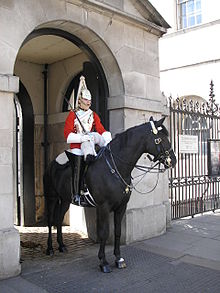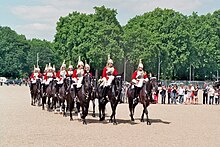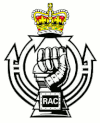Life guards
Life Guards ( German Leibgarde ) is the name of the oldest English guard cavalry regiment of the British army . Together with the Blues and Royals , the Life Guards form the Household Cavalry and thus also belong to the Household Division .
history
The Life Guards are the first active regiment in the British Army in the Order of Precedence , but not the oldest. They have their roots in a cavalry association of royalists who went into exile in Holland from 1658–61 under various names with the then prince and later King Charles II . After the Restoration in 1660, they were formed into three cavalry formations and after the union with Scotland a fourth was added. From them the 1st and 2nd Regiment of the Life Guards emerged in 1788, which were merged into one regiment in 1922.
The regiments not only provided the guard of the royal palace of Whitehall and the king's bodyguard, but also served as field regiments of the heavy cavalry. The traditional guarding of Whitehall is still carried out by them today. In the two world wars, the regiment was used on almost all fronts in Europe and North Africa on which British troops fought. In the post-war period, the regiment took part in the Falklands War and in many operations as part of UN peace missions. It was also used in the Second Gulf War and Iraq .
Since 1992 the Life Guards have been operationally combined with the other Guard Cavalry Regiment Blues and Royals to form the Household Cavalry Regiment and the Household Cavalry Mounted Regiment , but have retained their own uniforms, traditions and identity.
present
Today the Household Cavalry Regiment serves as an armored reconnaissance unit, while the Household Cavalry Mounted Regiment is used as a mounted guard regiment . It regularly participates in many important protocol events in Britain, such as Trooping the Color and (dismounted) the annual opening of Parliament . In addition, the regiment provides the mounted guard in front of Horse Guards .
Unlike in all other units of the British Army, the sergeants in the Guard Cavalry Regiments do not use the designation Sergeant , but have additional ranks based on the designation Corporal .
The Life Guards of the Household Cavalry Mounted Regiment can be recognized by their red uniform skirt and the white horsehair tail on the metal ax head .
Colonel of Honor of the regiment is Sir Edward Alexander Smyth-Osbourne . By virtue of this office, he and the Colonel of Honor are the Blues and Royals Gold Stick for England and Wales . This is a ceremonial office at court today; In the past, the gold stick was responsible for the monarch's personal safety.
Battle Honors
The regiment has received several Battle Honors (honorable mentions of battles in which it has participated), some of which are listed on the regimental flag. Here, too, it continues the traditions of its predecessor units.
List (English names):
- Maastricht 1673 , Sedgemoor 1685, Boyne 1690, Landen 1695
- Dettingen , Peninsula , Waterloo 1815 , Tel-el-Kebir , Egypt 1882 , Siege of Kimberley , Paardeberg , South Africa 1899–1900
- First World War : Mons , Le Cateau , Marne 1914 , Aisne 1914 , Messines 1914, Ypres 1914 '17 '18 , Somme 1916 '18 , Arras 1917 '18 , Hindenburg Line, France and Flanders 1914–18
- Second World War : Mont Pincon , Souleuvre, Noireau Crossing, Amiens 1944, Brussels, Neerpelt , Nederrijn, Nijmegen, Lingen, Bentheim, North-West Europe 1944–45, Baghdad 1941, Iraq 1941, Palmyra, Syria 1941 , El Alamein , North Africa 1942–43 , Arezzo, Advance to Florence, Gothic Line , Italy 1944
- Wadi al Batin, Gulf 1991 , Al Basrah, Iraq 2003


